一、什么是文件
磁盘上的文件就是文件
但在程序设计中,我们一般谈的文件有两种:程序文件、数据文件(功能角度分类)
1.程序文件
包括源文件(后缀为.c),目标文件(windows环境后缀为.obj),可执行程序(windows环境后缀为.exe)
2.数据文件
文件的内容不一定是程序,而是程序 运行时读写的数据,比如程序运行需要从中读取数据的文件
或者输出内容的文件
本文主要以数据文件为中心进行简介
3.文件名
文件名包含三个部分
文件路径+文件主干+文件后缀
eg: C:\code\test.txt
路径: C:\code
文件名主干: test
文件后缀: .txt
二、文件的打开和关闭
1.文件指针
每个被使用的文件都在内存开辟了一个相应的文件信息区
用来存放文件的相关信息(文件名,文件状态,文件当前位置等).
这些信息是保存在一个结构体变量中的.
该结构体系统声明取名为 FILE
即 FILE 是一个结构体类型
具体内部实现如下(不同环境下,结构成员会有所差异))
1
2
3
4
5
6
7
8
| struct _iobuf
{
};
typedef struct _iobuf FILE;
|
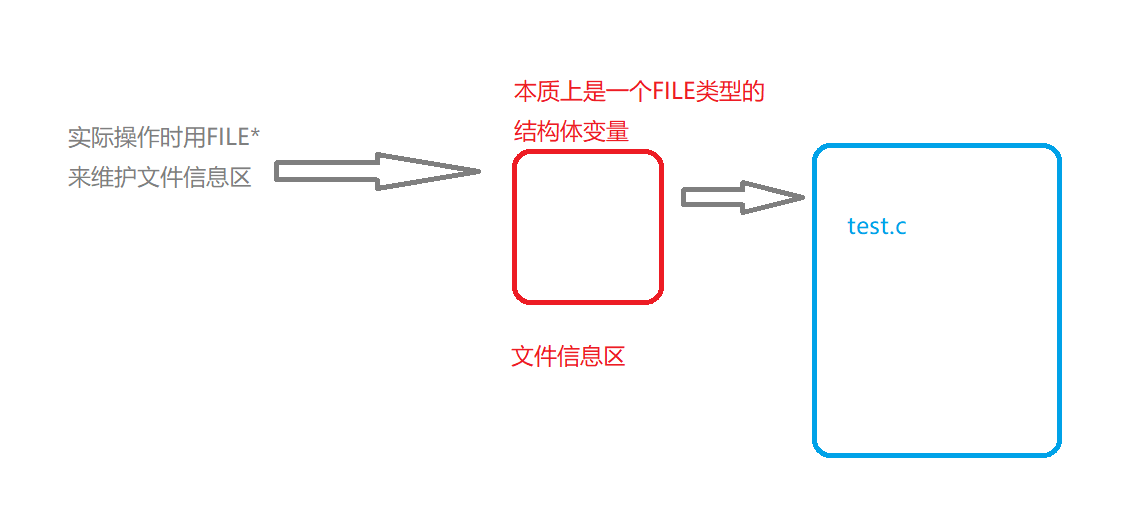
比如创建一个FILE*的指针变量
2.文件的打开和关闭
①fopen
1
2
3
| #include<stdio.h>
.
FILE*fopen(const char* filename,const char* mode);
|
以mode的形式打开filename文件
其中mode主要分为以下几种
| 文件使用方式 |
含义 |
如果指定文件不存在 |
| “r”(只读) |
为了输入数据,打开一个已经存在的文本文件 |
出错 |
| “w”(只写) |
为了输出数据,打开一个文本文件 |
建立一个新的文件 |
| “a”(追加) |
向文本文件尾添加数据 |
建立一个新的文件 |
| “rb” (只读) |
为了输入数据,打开一个二进制文件 |
出错 |
| “wb”(只写) |
为了输出数据,打开一个二进制文件 |
建立一个新的文件 |
| “ab” (追加) |
向一个二进制文件尾添加数据 |
出错 |
| “r+”(读写) |
为了读和写,打开一个文本文件 |
出错 |
| “w+”(读写) |
为了读和写,建立一个新文件 |
建立一个新的文件 |
| “a+”(读写) |
打开一个文件,在文件尾进行读写 |
建立一个新的文件 |
| “rb+”(读写) |
为了读和写,打开一个二进制文件 |
出错 |
| “wb+”(读写) |
为了读和写,建立一个二进制文件 |
建立一个新的文件 |
| “ab+”(读写) |
打开一个二进制文件,在文件尾进行读和写 |
建立一个新的文件 |
以一段代码介绍fopen实际使用
1
2
3
4
5
6
7
8
9
10
11
12
13
14
15
16
| FILE * pf = fopen("test.dat","r");
FILE * pf = fopen("D:\\2023_code\\class\\test.dat","r");
if(pf == NULL)
{
perror("fopen");
return 1;
}
fclose(pf);
pf = NULL;
|
②fclose
1
2
3
| #include<stdio.h>
.
int fclose(FILE* stream);
|
三、文件的顺序读写
1.读写函数表
| 功能 |
函数名 |
适用于 |
| 字符输入函数 |
fgetc |
所有输入流 |
| 字符输出函数 |
fputc |
所有输出流 |
| 文本行输入函数 |
fgets |
所有输入流 |
| 文本行输出函数 |
fputs |
所有输出流 |
| 格式化输入函数 |
fscanf |
所有输入流 |
| 格式化输出函数 |
fprintf |
所有输出流 |
| 二进制输入 |
fread |
文件 |
| 二进制输出 |
fwrite |
文件 |
2.”输入”,”输出”是什么
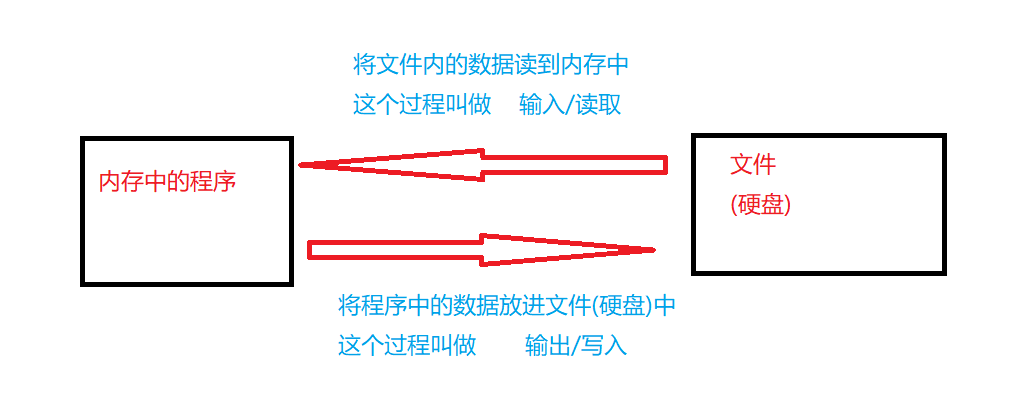
3.流
流是一个高度抽象的概念
同样的我们以图的形式展现流
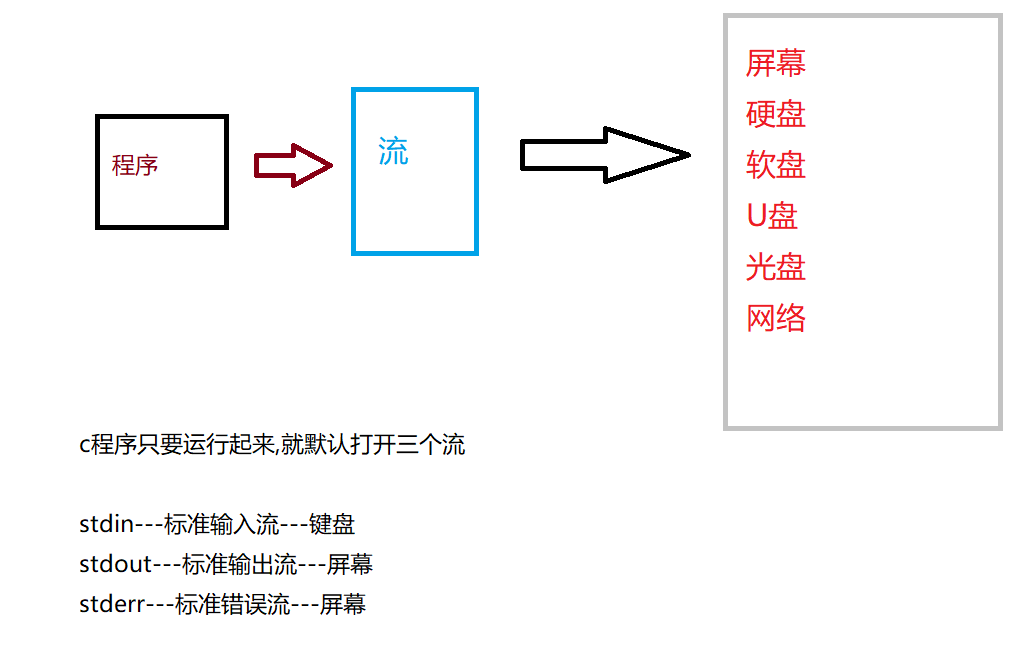
具体理解可能略微生硬
在fputc中我们可以在逐渐深入了解
4.fputc
1
2
3
| #include<stdio.h>
.
int fputc(int c,FILE*stream);
|
将一个字符c,输出到 stream(输出流) 中
举一个实例
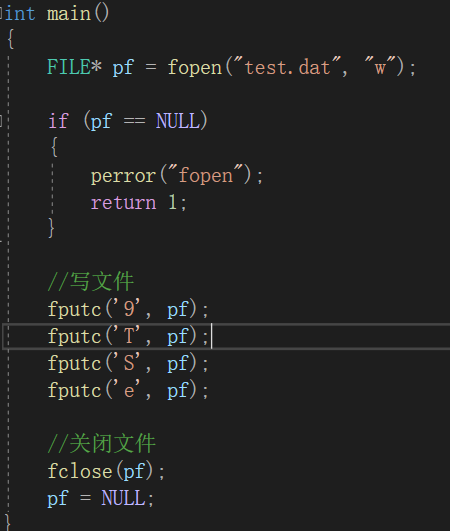
函数运行后观察该项目文件夹
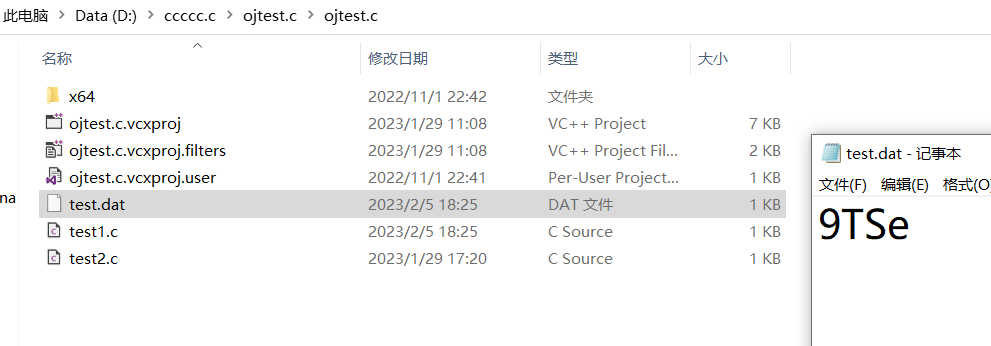
文件夹内创建了我们输入的文件名,并向文件内输出了我们想要的结果
当然输出流可以改变,比如stdout(标准输出流–屏幕)
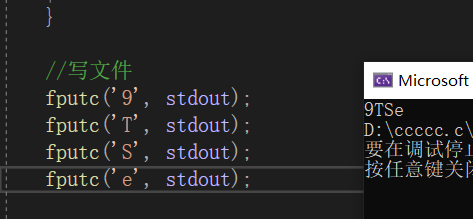
5.fgetc
1
2
3
| #include<stdio.h>
.
int fgetc(FILE * stream);
|
从流中读取单字符
每使用一次向后偏移一次
若读取失败则返回EOF( -1 )
举个例子

先将要读取的文件加入字符
运行程序后
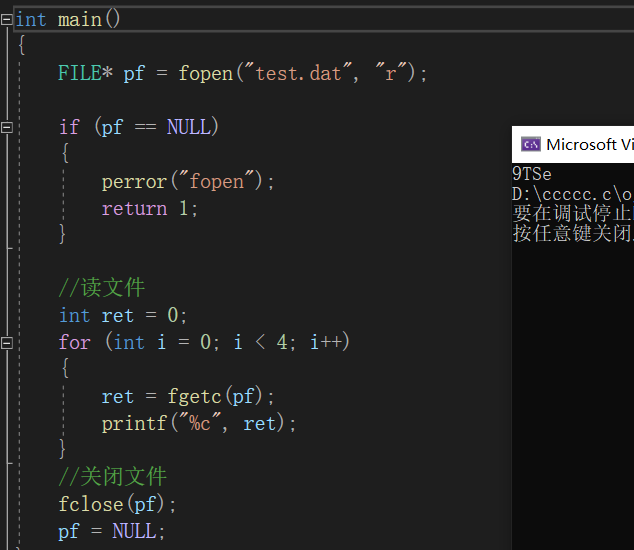
同样的,输入流也可以不仅仅是文件,也可以是stdin(标准输入流—键盘)

输入后再打印
6.fputs
1
2
3
| #include<stdio.h>
.
int fputs(const char * string, FILE * stream);
|
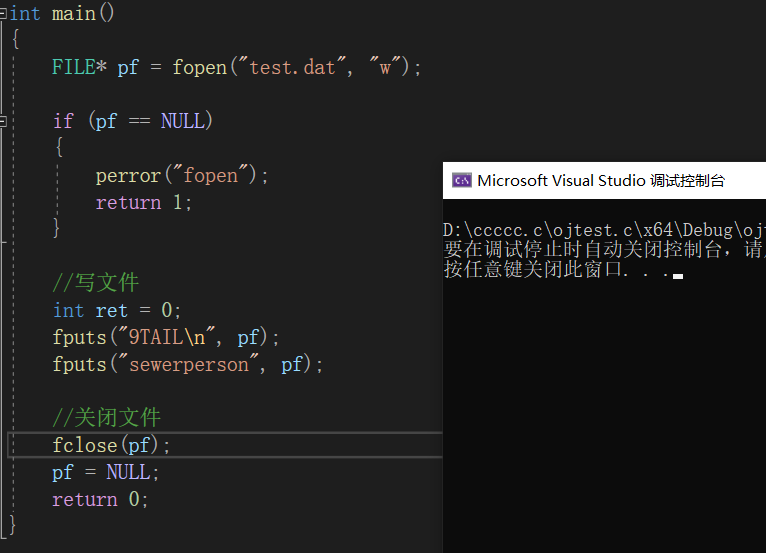
7.fgets
1
2
3
| #include<stdio.h>
.
char * fgets(char * string , int n ,FILE * stream);
|
从流中读取最多n个字符到string
返回string的地址
举个例子

在文件中提前放入字符串
然后读取打印
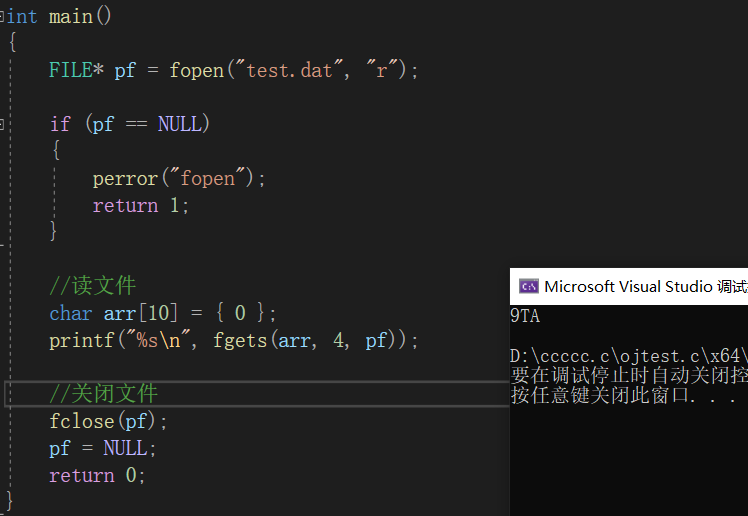
可以看到打印成功
但是之所以只打印了三个字符
是因为需要预留一字节空间存储'\0'
8.fprintf
1
2
3
| #include<stdio.h>
.
int fprintf(FILE * stream , const char * format [,argument]....);
|
1
2
3
4
5
6
7
8
9
10
11
12
13
14
15
16
17
18
19
20
21
22
23
24
25
26
27
28
| struct S
{
char arr[10];
int num;
float sc;
};
int main()
{
struct S s = {"abcdef",10,5.5f};
FILE*pf = fopen("test.dat","w");
if(pf == NULL)
{
perror("fopen");
return 1;
}
fprintf(pf,"%s %d %f",s.arr,s.num,s.sc);
fclose(pf);
pf = NULL;
return 0;
}
|
fprintf也可以适用于其他输出流
9.fscanf
1
2
3
| #include<stdio.h>
.
int fscanf(FILE*stream, const char * format[,argument]....);
|
继上一段代码将结构中的数据存储于文件中
我们也可以读取文件中的结构
1
2
3
4
5
6
7
8
9
10
11
12
13
14
15
16
17
18
19
20
21
22
23
24
25
26
27
28
29
30
31
32
33
34
35
36
37
38
39
| struct S
{
char arr[10];
int num;
float sc;
};
struct A
{
char arr[10];
int num;
float sc;
};
int main()
{
FILE*pf = fopen("test.dat","r");
if(pf == NULL)
{
perror("fopen");
return 1;
}
struct S s = {0};
fscanf(pf,"%s %d %f",s.arr,s.num,s.sc);
fscanf(pf,"%s %d %f",a.arr,a.num,a.sc);
printf("%s %d %f",s.arr,s.num,s.sc);
fclose(pf);
pf = NULL;
return 0;
}
|
也可使用于其他流
10.fwrite
1
2
3
| #include<stdio.h>
.
size_t fwrite(const void*buffer,size_t isze,size_t count,FILE* stream);
|
该函数作用是
再stream流中写入大小为size,个数为count的二进制buffer数据
1
2
3
4
5
6
7
8
9
10
11
12
13
14
15
16
17
18
19
20
21
22
23
24
25
26
27
28
29
| struct S
{
char arr[10];
int num;
float sc;
};
int main()
{
FILE*pf = fopen("test.dat","w");
if(pf == NULL)
{
perror("fopen");
return 1;
}
struct S s = { "abcde",10,5.5f };
fwrite(&s,sizeof(struct S),1,pf);
fclose(pf);
pf = NULL;
return 0;
}
|

二进制数据
引出fread函数
11.fread
1
2
3
| #include<stdio.h>
.
size_t fread(void * buffer,size_t size,size_t count,FILE*stream);
|
该函数作用为
从stream流中读取count个大小为size的数据放入buffer内
我们以上述代码带入的结果测试一下
1
2
3
4
5
6
7
8
9
10
11
12
13
14
15
16
17
18
19
20
21
22
23
24
25
26
27
28
29
30
31
32
| struct S
{
char arr[10];
int num;
float sc;
};
int main()
{
FILE*pf = fopen("test.dat","r");
if(pf == NULL)
{
perror("fopen");
return 1;
}
struct S s = {0};
fread(&s,sizeof(struct S),1,pf);
printf("%s %d %f",s.arr,s.num,s.sc);
fclose(pf);
pf = NULL;
return 0;
}
|
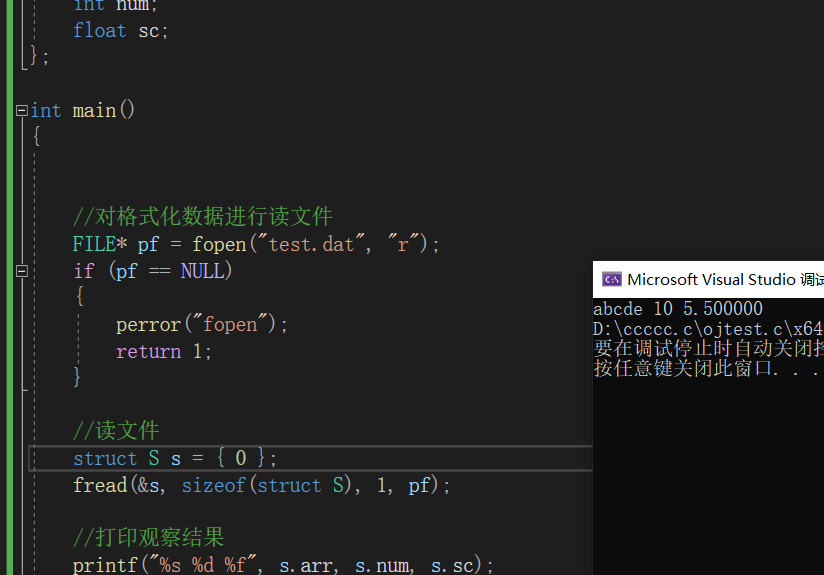
二进制数据可以被读取为我们可以读懂的数据
12.sscanf、sprintf
1
2
3
| #include<stdio.h>
.
int sscanf(const char * buffer,const char*format[,argument]...);
|
从一段被格式化转换为字符串的数据
还原出原本的格式化数据
1
2
3
| #include<stdio,h>
.
int sprintf(char*buffer,const char*format[,argumen]...);
|
把一个格式化的数据(包含各种类型)
转化为字符串存储至buffer
1
2
3
4
5
6
7
8
9
10
11
12
13
14
15
16
17
18
| struct S
{
char arr[10];
int age;
float f;
};
int main()
{
struct S s = {"hello",20,5.5f};
char buf[100] = {0};
sprintf(buf,"%s %d %f",s.arr,s.age,s.f);
printf("%s\n",buf);
return 0;
}
|
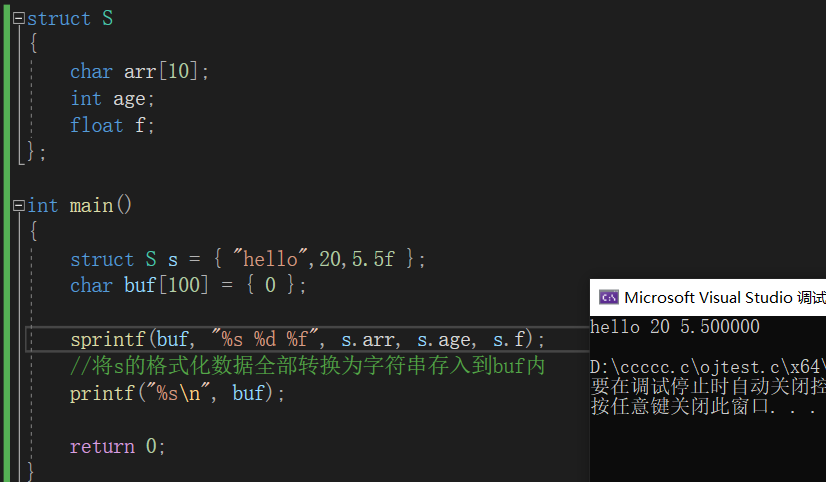
打印结果如上
我们还可以将这段字符串通过fscanf还原出结构中的数据
1
2
3
4
5
6
7
8
9
10
11
12
13
14
15
16
17
18
19
20
21
22
23
24
| struct S
{
char arr[10];
int age;
float f;
};
int main()
{
struct S s = {"hello",20,5.5f};
struct S tmp = {0};
char buf[100] = {0};
sprintf(buf,"%s %d %f",s.arr,s.age,s.f);
printf("%s\n",buf);
sscanf(buf, "%s %d %f",tmp.arr,&(tmp.age),&(tmp.f));
printf("%s %d %f\n",tmp.arr,tmp.age,tmp.f);
return 0;
}
|
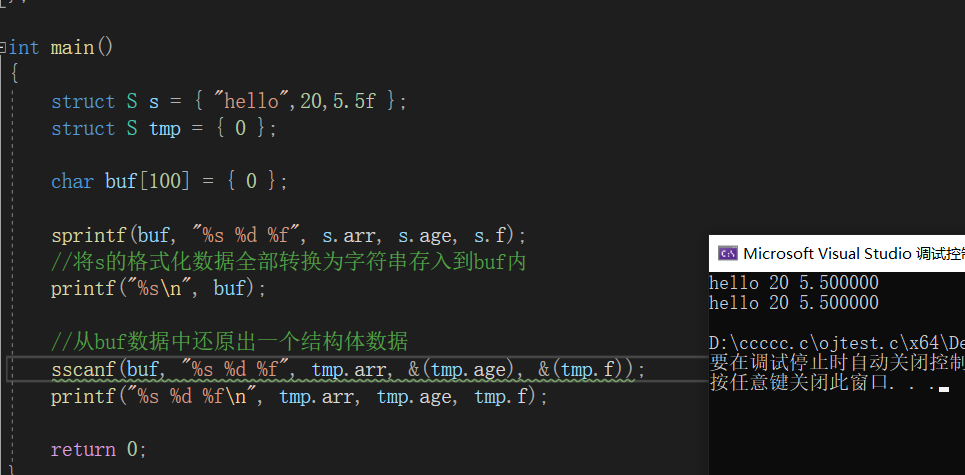
四、文件的随机读写
在文件顺序读写中,我们发现以fgetc为例
总是从第一个字符开始,并向后逐一递增
怎样可以自定义读写方式呢
这里就要用到文件随机读写的知识
1.fseek
1
2
3
| #include<stdio.h>
.
int fseek(FILE * stream,long int offset,int origin);
|
将指针定位至与起始位置 origin 偏移 offset 的位置
origin分为三种情况
SEEK_CUR — 当前文件指针的位置
SEEK_END — 文件末尾
SEEK_SET — 文件的起始位置
测试一下实际情况

1
2
3
4
5
6
7
8
9
10
11
12
13
14
15
16
17
18
19
20
21
22
23
24
25
26
27
28
29
| int main()
{
FILE* pf = fopen("test.dat","r");
if(pf == NULL)
{
perror("fopen");
return 1;
}
int ch = fgetc(pf);
printf("%c\n",ch);
fseek(pf,1,SEEK_CUR);
ch = fgetc(pf);
printf("%c\n",ch);
ch = fgetc(pf);
printf("%c\n",ch);
fclose(pf);
pf=NULL;
return 0;
}
|
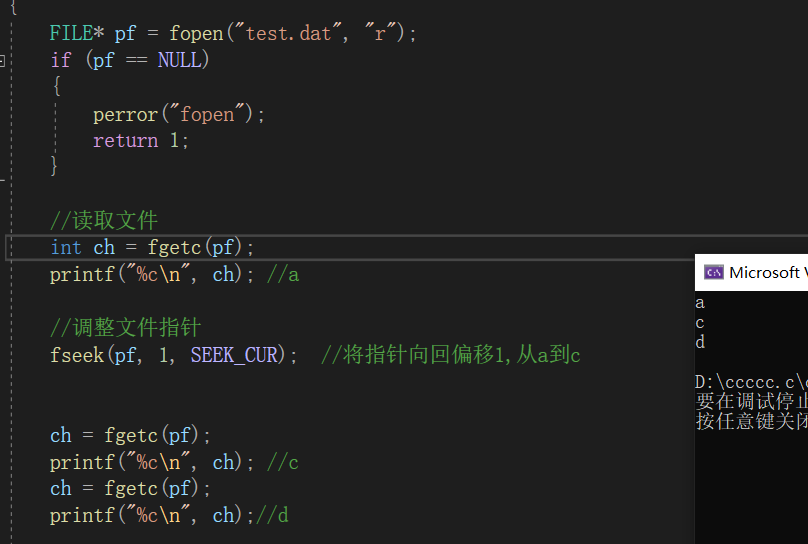
2.ftell
1
2
3
| #include<stdio.h>
.
long int ftell(FILE * stream);
|
返回文件指针相对于起始位置的偏移量
1
2
3
4
5
6
7
8
9
10
11
12
13
14
15
16
17
18
19
20
21
22
23
24
25
26
27
28
29
30
31
| int main()
{
FILE* pf = fopen("test.dat","r");
if(pf == NULL)
{
perror("fopen");
return 1;
}
int ch = fgetc(pf);
printf("%c\n",ch);
fseek(pf,1,SEEK_CUR);
ch = fgetc(pf);
printf("%c\n",ch);
ch = fgetc(pf);
printf("%c\n",ch);
int ret = ftell(pf);
printf("%d",ret);
fclose(pf);
pf=NULL;
return 0;
}
|
3.rewind
1
2
3
| #include<stdio.h>
.
void rewind(FILE*stream);
|
让文件指针回到起始的位置
还以上述举例
1
2
3
4
5
6
7
8
9
10
11
12
13
14
15
16
17
18
19
20
21
22
23
24
25
26
27
28
29
30
31
32
33
34
35
| int main()
{
FILE* pf = fopen("test.dat", "r");
if (pf == NULL)
{
perror("fopen");
return 1;
}
fseek(pf, 3, SEEK_CUR);
int ch = fgetc(pf);
printf("%c\n", ch);
int ret = ftell(pf);
printf("%d\n", ret);
rewind(pf);
ret = ftell(pf);
printf("%d\n", ret);
ch = fgetc(pf);
printf("%c\n", ch);
fclose(pf);
pf = NULL;
return 0;
}
|
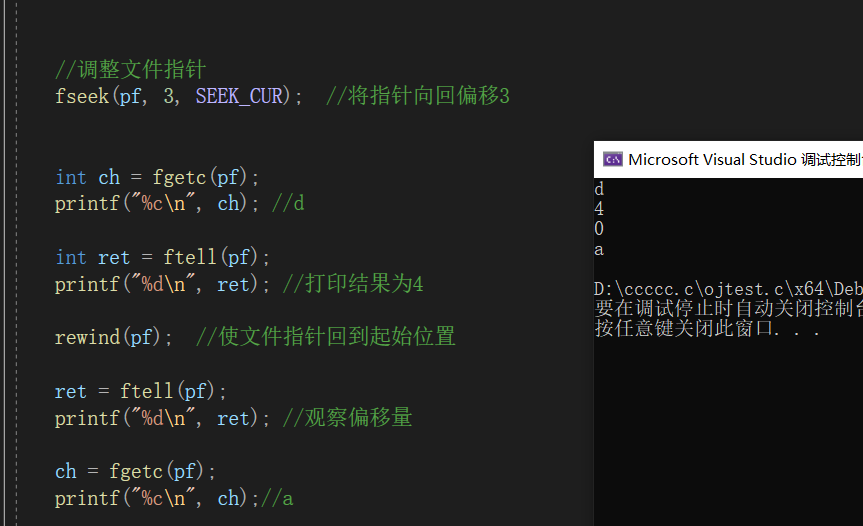
五、文件读取结束的判定(feof)
feof的作用使
判断文件是读取失败结束的,还是遇到文件尾结束的
对于文本文件:
通过判定返回值来确定
判断返回值是否尾EOF(fgetc),或者NULL(fgets)
fgetc函数在读取结束后返回的是EOF
正常读取时返回的是读取到的字符的ASCII值
fgets函数在读取结束时返回的是NULL
正常读取时返回的是,存放字符串空间的起始地址
对于二进制文件:
判断返回值是否小于实际要读的个数
fread函数在读取的时候,返回的是实际读取到的完整元素的个数
如果发现读取到完整的元素个数小于 指定元素个数,这就是最后一次读取
举个例子
1
2
3
4
5
6
7
8
9
10
11
12
13
14
15
16
17
18
19
20
21
22
23
24
25
26
27
28
29
30
31
32
33
34
35
36
37
38
39
40
41
42
43
44
|
int main()
{
FILE * pread = fopen("test.txt","r");
if(pread == NULL)
{
perror("pread");
return 1;
}
FILE * pwrite = fopen("test.txt2","w");
if(pwrite == NULL)
{
fclose(pread);
pread = NULL;
return 1;
}
int ch = 0;
while( ch = fgetc(fread) != EOF)
{
fputc(ch,fwrite);
}
if(feof(pread))
{
printf("遇到文件结束标志,文件正常结束");
}
else if(ferror(pread)
{
printf("文件读取失败");
}
fclose(pread);
pread = NULL;
fclose(pwrite);
pwrite = NULL;
}
|
六、文件缓冲区
简而言之就是
从程序到文件、从文件到程序
必须塞够足够的数据或者刷新( fflush (pf) )(高版本无法使用刷新)
数据才会完全输送到目的地
七、文本文件和二进制文件
1.数据在内存中以二进制的形式存储,如果不加以转换输出到外存,就是二进制文件
2.如果要求在外存以ASCII的形式存储,则需要在存储前转换
以ASCII字符的形式存储的文件就是文本文件
一个数据在内存中是怎么存储的呢
字符一律以ASCII形式存储
数值即可以ASCII存储也可以二进制形式存储
假设整数10000
ASCII存储需要5个字符 –五字节
而二进制只需要占4字节 –转换为二进制再转换为16进制计算






















